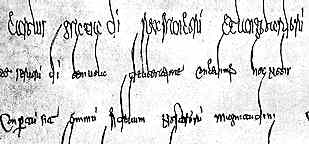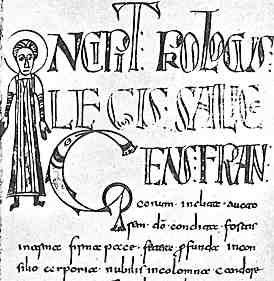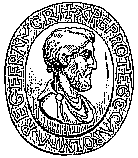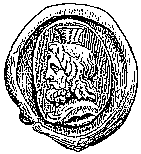





If you are looking at this page without frames, there is more information about medieval writing to be found by going to the home page (framed) or the site map (no frames).
| Scribes and Libraries of the Carolingian Court (3) | ||||||
| The standardisation and clarification of texts was accompanied by the standardisation and clarification of handwriting. The various monastic centres of writing had developed a range of scripts for book production, all derived from New Roman cursive, but quite diverse in appearance. Many were quite elaborately calligraphic, but some were difficult to read. The new standard script, now referred to as Caroline minuscule, was neat and clear, compact so that long texts could be packed into relatively small spaces, and uniform across many book production centres. | ||||||
| The new script was not suddenly invented, but became progressively and quite rapidly more standardised as various idiosyncratic forms became less common. | ||||||
|
|
Segment from an early 9th century copy of Benedict's Rule (St Gall, Stiftsbibliothek, 914, f.25v). (From Steffens 1929) | |||||
| The above example of Caroline minuscule retains some older forms, such as the occasional use of the open topped a as in labia on the top line, the open g and the use of ligatures like the ri in gloria on the bottom line. | ||||||
| The new script became established in prestigious works produced in abbeys of the kingdom or by the court school, such as the great Maurdramnus Bible written at Corbie or the group of manuscripts referred to as the Ada group because of a dedication in one of them to Ada, supposed to be Charlemagne's sister. | ||||||
 |
The Ada Gospels of the late 8th century (Treves, Stadtbibliothek, Bibelhandschriften 22 (Codex aureus), p.17). (From Steffens 1929) | |||||
| The above example has the occasional open a, as in habebit on the second line, and sometimes uses a majuscule N. However, most letters have the familiar form of Caroline minuscule. | ||||||
| This clear and universally comprehensible script spread across book production areas in Europe until, by the 10th century, it covered most of the literate world where Latin was the language of liturgy and law. However, the Carolingian chancery did not adopt it themselves for their legal documents, which continued to be produced for some time in the compressed, spidery and almost illegible Merovingian chancery script. | ||||||
 |
Segment of a diploma of Charlemagne from AD 781 (State Archives, Marburg). (From Steffens 1929). | |||||
| This may indicate that different scribes were producing the books to those producing diplomas. The book scribes were undoubtedly clerics and many, if not all, were operating from within religious institutions rather than the court as such. The chancery scribes derived their training from the legal system of Roman antiquity, and may have been a specialised group. Alternatively, It may simply have been conceived that there were two proper ways of doing two different jobs. | ||||||
| The surviving works from the Carolingian period are written in Latin, but Einhard gives us the tantalising tidbit that Charlemagne ordered the barbarous and ancient narrative poems of his own language to be written down. He supposedly also began a grammar of his native Frankish tongue, and invented various words in it for the names of the months and the winds. If this occurred, the works have not survived. Perhaps it was an idea whose time had not yet come, and subsequent scribes neglected to copy these imperial oddities. Vernacular works derived from the Germanic oral tradition do not appear in the record until the romances of the 12th and 13th centuries. | ||||||
| Einhard also refers to Charlemagne having the Frankish codes of law committed to writing, thereby indicating that, vestiges of literate Roman legal practice notwithstanding, the laws themselves were part of oral tradition. |
 |
|||||
| Prologue to the Lex Salica in a manuscript of AD 793 (St Gall Stiftsbibliothek, Codex 731). (From Steffens 1929) | ||||||
| In the example above, the script contains many old letter forms and ligatures from Merovingian minuscule book hand. The text is evidently corrupt, with many errors in the Latin. Perhaps this was a problem with writing in Latin a text which derived from another language, rather than having a tradition of Latin exemplars to copy. | ||||||
| The use of written record in government and administration increased markedly during the reign of Charlemagne as compared to preceding eras. Royal diplomas as well as private charters served as title to land or privileges. Various forms of written instruction were issued to officials and information submitted in written form to the central authority. Legal cases were recorded. The crown issued written statements called capitularies announcing royal decisions or legal matters. Hundreds of these survive, but nearly all in copies from the 10th century or later. | ||||||
 |
Two seals of Charlemagne, both derived from antique intaglio gems. The one on the left depicts a Roman emperor, that on the right an Egyptian deity. |
 |
||||
| While one assumes there was a chancery in the sense that there were royal scribes and a royal archive, it is not known how it was organised. There may not have been many royal scribes, as their is no evidence for mass production of identical forms of documents from central authority. The scribes may have been clergy acting in the service of the king rather than purpose trained public servants. It has been suggested that notaries in countries north of the Alps were mostly priests or monks, and that lay notaries, as existed in ancient Rome, were largely confined to Italy. Authority most likely lay in a combination of written and oral announcement. Officials trundled off around the Frankish empire with written instructions in their saddlebags, but oral proclamation of their contents may have been just as significant a part of the process. The texts of capitularies, as now found in later copies, may have been recorded by listeners to oral proclamation rather than copyists of documents. Writing was important, but it wasn't everything. | ||||||
|
|
||||||
|
|
||||||
|
|
||||||
|
If you are looking at this page without frames, there is more information about medieval writing to be found by going to the home page (framed) or the site map (no frames). |
||||||